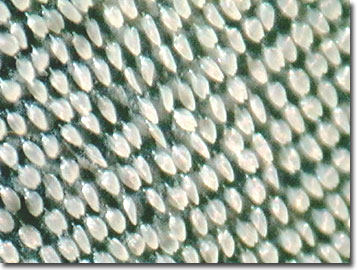Butterfly Wing Scale Digital Image Gallery
Zebra Swallowtail Butterfly
When people ask "what is black and white and red all over?" they often are referring to those old riddles about newspapers and embarrassed zebras. In the world of Lepidoptera, however, they can only mean the aptly named zebra swallowtail butterfly. A striking, but common insect species of North America, the zebra swallowtail features a very distinctive bold black and white striped wing pattern highlighted by brilliant red median stripes.

In warmer climes, such as Florida and the Deep South, three broods of zebra swallowtails, scientifically described as Eurytides marcellus, are completed per year. On the northern edge of its range, however, two reproductive cycles are the norm. Adults that emerge during the spring are usually smaller, paler, and have shorter tails than later broods, and summer and autumn cohorts are progressively larger and darker. Yet, no matter what their appearance, zebra swallowtails can be distinguished from other swallowtail butterfly species in flight by their characteristic close-to-the-ground forays, very direct flight paths, and rapid wing beats.
Adult zebra swallowtail butterflies need large amounts of energy to complete their life functions. Nectar sources for mature zebra swallowtails include the flowers of blueberry, blackberry, lilac, redbud, and common milkweed plants. Adults drink the sweet flower nectar with their coilable proboscises, but unlike most butterflies, can also ingest pollen. When pollen is digested and its amino acids absorbed, the butterflies receive extra energy and nutrition for mating and reproduction. Male zebra swallowtails gather additional nutrients and salts from mud puddles, damp sand, and animal dung.
Zebra swallowtail caterpillars prefer young plants as hosts and exclusively feed upon the pawpaw. Formidable in size and appearance, the late larval instars are hard to overlook due to their characteristic humped backs and pale green bodies covered in loud blue, black, and yellow rings. When disturbed the caterpillars emit a repulsive chemical substance from their osmeteria, a pair of fleshy orange neck glands, in hopes of deterring predators. The substance does not deter others of its own species, however, and the voracious caterpillars are sometimes cannibalistic.
Although urban sprawl and pesticide applications take their toll on populations of zebra swallowtails, the butterflies are generally doing quite well. Forestry practices that favor maintaining pawpaw trees in various stages of succession, aid their conservation. Moreover, on account of their large size, high host plant specificity, and bold coloration, zebra swallowtail butterflies are often the stars of butterfly conservatories and home butterfly gardens.
Zebra Swallowtail Butterfly Images in Reflected Light
Multi-Colored Wing Scales and Fur - This photomicrograph displays wing scales that seem to fade from black through progressively lighter shades until a pearly white is achieved. Wispy strands of fur can also be clearly discerned.
White Wing Scales and Vein - The shiny white scales of a zebra swallowtail butterfly surround a branching vein in this splendid reflected light image.
Contributing Authors
Cynthia D. Kelly, Shannon H. Neaves, Laurence D. Zuckerman, and Michael W. Davidson - National High Magnetic Field Laboratory, 1800 East Paul Dirac Dr., The Florida State University, Tallahassee, Florida, 32310.
BACK TO THE BUTTERFLY WING SCALE IMAGE GALLERY
BACK TO THE DIGITAL IMAGE GALLERIES
Questions or comments? Send us an email.
© 1995-2022 by Michael W. Davidson and The Florida State University. All Rights Reserved. No images, graphics, software, scripts, or applets may be reproduced or used in any manner without permission from the copyright holders. Use of this website means you agree to all of the Legal Terms and Conditions set forth by the owners.
This website is maintained by our
Graphics & Web Programming Team
in collaboration with Optical Microscopy at the
National High Magnetic Field Laboratory.
Last Modification Friday, Nov 13, 2015 at 02:19 PM
Access Count Since January 21, 2003: 23113
Visit the website of our partner in introductory microscopy education:
|
|
